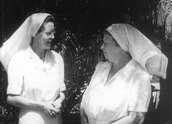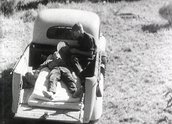


The Inlanders (1949)
Synopsis
A documentary by John Kingsford Smith made for the Australian Inland Mission. The Inlanders follows patrolling minister Reverend KF ‘Skipper’ Partridge on his 8,690 kilometre journey into Australia’s remote communities to tend to the physical, spiritual and intellectual needs of the people. The film shows some of the work undertaken by the Australian Inland Mission and also the work of the Royal Flying Doctor Service, established by AIM founder the Reverend John Flynn. It presents aspects of work life in remote Australia including gold, opal and coal mining, cattle mustering and branding, and communications services conducted by radio, telephone and Morse typewriter.
The film is narrated by a male voice-over and incorporates an instrumental soundtrack.
Curator’s notes
Made three years after The Overlanders (1946) and five years before Back of Beyond (1954), The Inlanders comes from a tradition of fiction and non-fiction filmmaking that grapples with Australia’s vast landscape and presents the outback as a harsh and hostile terrain to be overcome. There is certainly overlapping territory between Back of Beyond (1954) and Kingsford Smith’s film in the way the latter incorporates drama into the narrative (see clip two), and in its focus on a sense of community amongst the inhabitants of some of the country’s most isolated locations. Skipper Partridge’s inland patrol takes him on a zigzag journey from Broken Hill – north to Tibooburra, to the northeast corner of South Australia, west to Birdsville, south to Marree and Leigh Creek in South Australia, north to Oodnadatta, south to Coober Pedy and finally north again to Alice Springs. The trip crisscrosses some of the Birdsville Track – the route taken by Royal Mailman Tom Kruse in John Heyer’s film The Back of Beyond (1954) – and similarly takes its narrative direction from the journey. Along the way (especially in the first half of the film), the film digresses to place Skipper’s current mission patrol in the broader context of the Australian Inland Mission’s work. The Reverend John Flynn, founder of the Australian Inland Mission and brainchild of what became the Royal Flying Doctor Service, is introduced early on in the film (see clip one) and the AIM nursing hostels at Oodnadatta, Birdsville and Alice Springs are presented as the lifeline of the remote communities they service.
John Kingsford Smith was approached by the Australian Inland Mission (now Frontier Services) to record Reverend Partridge’s patrol in 1947. Kingsford Smith had wanted to shoot a film in central Australia for some years and this was the perfect opportunity. The warm reception of the documentary both in Australia and in Britain ensured that Kingsford Smith, with his newly formed production company Kingcroft Australia, became a successful and prolific producer of documentaries over the following two decades.
The Australian Inland Mission began servicing the health and human needs of remote and isolated communities (both Indigenous and non-Indigenous) in 1912, when Flynn identified a need to establish a ‘mantle of safety’ in the region. AIM patrols of the country’s interior have been documented on film since the 1920s and some of these are preserved at the National Film and Sound Archive.
Segments of the footage filmed for The Inlanders were released as part of a silent, colour documentary called Beyond the Furthest Fences in 1947.
- Overview
- Curator’s notes
- Video 3 clips
- Principal credits
- Find a copy
- Make a comment
- Map
- Add your review



